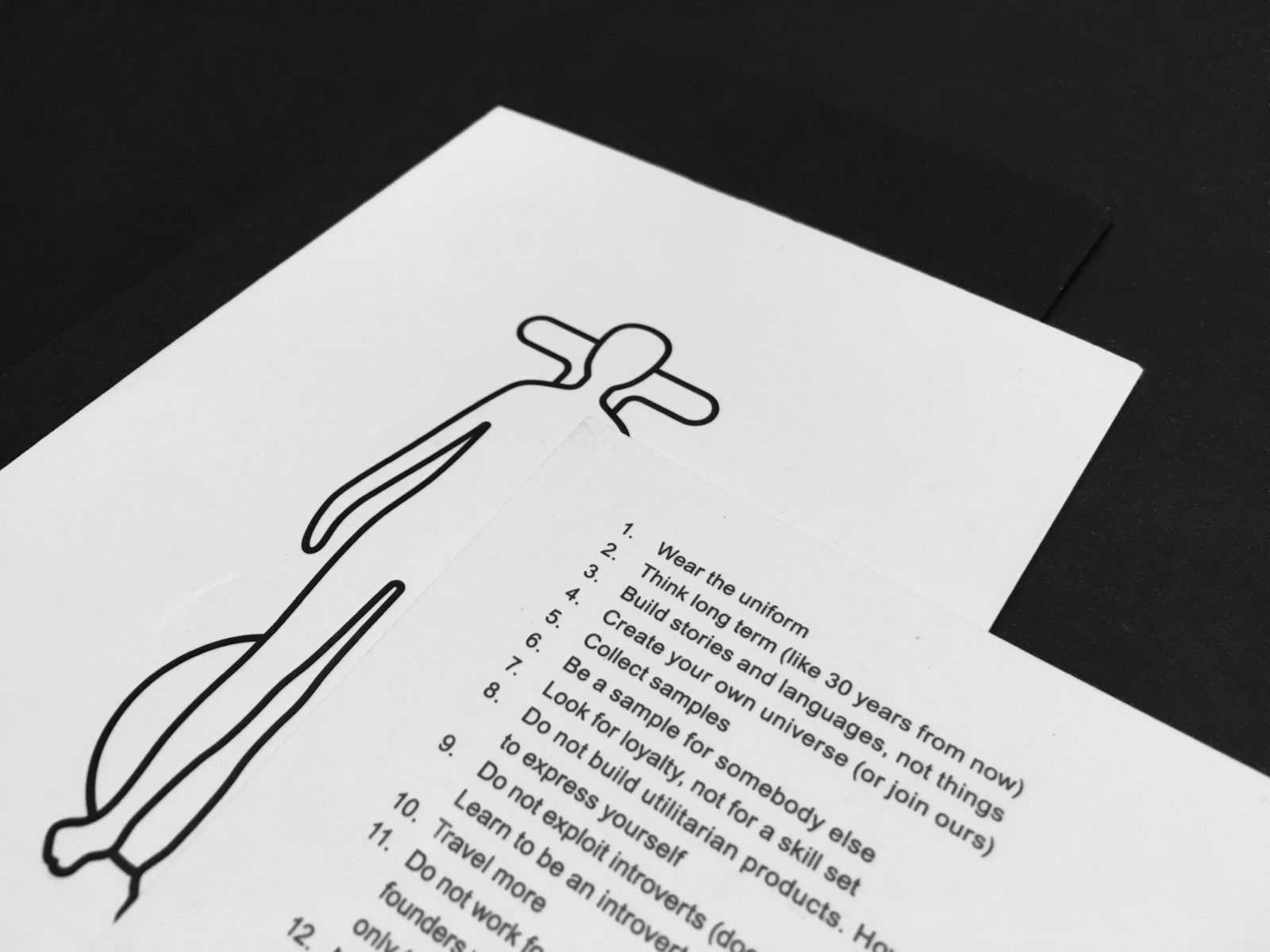LOT is an AI-driven subscription for anonymous but personalized apparel. Here, the holy grail of fashion—distinction—is absent in the pieces and transfered to the context of the label. Their combination of products, communication and ideology make for a “UX design” that deserves the term. A review after 8 months.
Looking at the pieces, I prefer to say clothes instead of fashion: all black, simple cuts, cotton, a little bit of plastic. Kind of what is filed under “basics” in the retail stores of the big chains, minus the colors—anonymous industry standard. It’s hard to believe that these pieces are the reason why customers are quite enthusiastic about the brand. Something different must be going on when the monthly package from Shenzen arrives.
Nice Intelligence
This article, discussing the intersection of fashion and artificial intelligence, brought LOT to my attention and shaped my expectations. Until then, I had always been thinking about AI in rather maximized versions such as AlphaGo. By using LOT I got to meet a far more subtle version.
In the beginning, the machine (NOT algorithm) asks me to go through a list of options. The length of my socks, type of underwear, the prefered form of my sweater’s collar. Usually, I would navigate different groups of products on a website, here the journey is aligned with my body. A small but powerful inversion, since it’s me who is at the center of attention, not the sales structure of a company trying to force things onto me.
This is being reinforced by a sketch that I personalize with my measurements. This is where I expected AI to step in, using these measurements to fabricate tailored pieces. But no, this is a feature yet to come, right now I choose my sizes the classic way (L, XL etc.) and may change them after every monthly delivery. AI is rather a promise to the future, but is already being used for marketing.



The second capability of the machine moves towards individualization as well, I find my name printed on a poster and a pair of shoes. The twist is to have an anonymous, rather faceless piece of clothing with a personal name on it. But, one step back, just by applying a tiny print which is hardly recognizable for passers-by. Individualization takes place, but is restrained and does not show off—an update of an old school gesture of luxury.
AI and Trust
Most interestingly, the whole setting works like an antidote to the clichés of AI-powered surveillance and robotic control. This machine is not indecipherable and evil, on the contrary: I can see exactly what it is capable of and what it does (just as I seem to know what it can’t do). This creates trust. It lulls me into answering extremely personal questions each time I visit the website. Casual, next door questions: Do you have children? Do you cook? Do you excercise? I go along with it although I have no clue what these answers are being used for. I don’t know what this intellgence will have done to me.

Work and environment: the parcels arrive from Hong Kong, i.e. per airfreight. Which is a mess in terms of CO2 emissions, compared to ships. Those, on the other hand, emit large amounts of sulfur and nitric oxides—I could not find a meaningful comparison of the overall environmental costs.
The production conditions are unknown and no part of the label’s marketing, neither regarding work nor environment. But at a price point of 50$ per package you better not expect too much happiness in both departments.
The general attitude seems to waver between disinterest and ambivalence. A certain awareness is visible: the products of my very first delivery were wrapped in plastic, afterwards they switched to recycled paper—by request of the customers. In addition, the Code of Practice demands to think long term, but also wants you to travel more often, a killer when it comes to emissions. Let’s leave it at typical contemporary contradictions.
Reduction
The main selling point is relief. To plug into LOT “is a kind of freedom to stop thinking about fashion, freeing the mind for loftier things – like contemplating mortality”, as the above mentioned article quotes. One thing less to worry about is a good thing, aside from the annoying buzz around fashion.
LOT creates four points of relief: service, ideology, communication, abolition of distinction.
Service
The subscription covers your need for basic items. With the larger plan you get your soap and other necessities (tattoo machine, errrr…). Underwear, socks, T-shirts, trousers, sneakers etc.
Ideological superstructure
Once upon a time you would have called it a manifest, now it is a Code of Practice. Still, it is made of instructions on how to perceive, act and live. Nowadays those instructions don’t come from philosophy or politics, but from a company. “Build stories and languages, not things”. Or: “Do not work for corporations”. Or “Fuck likes, followers, fake lives, fake friends”. Or “Your phone is a temporary feature — don’t spend your life on it”. You see what this is about. The expectably silly and paradoxical message is that a fashion label proposes a contra-consumption pamphlet, featuring standardized subjects to your approval. But in reverse you have to ask yourself what other brands are shouting at you (although you might not hear it right away).
LOT has also learned from another classic quote: If I can’t dance, it’s not my revolution. So there are mix tapes, stickers, cards, posters, useless wristbands etc. This kind of cryptic playfulness acts as a counterpart to the strictness of the clothes and the writing. Moreover, there are real life meetings, twitch session, users in residence. LOT tries to draw you in, using a vast variety of means and channels.
Communication & Interfaces
The big-mouthed Code of Practice is acceptable only because the ideas propagated therein are being nicely executed on the level of the service itself. This starts with the administration of me as a user: I only exist as an email-address (and a set of credit card data, sure). I get a verification link each time I want to enter my account. There is no login, no contact field, no terms of service, no routines for returns, no ratings etc. The only way to LOT is the email.
Like that, you instantly feel the peskiness of all the other companies’ interfaces you have been using so far. There is so much nerve-racking clutter between you and the products: passwords, colors, shapes, sizes, options you have to process again and again. Advertisements that are harrassing you even while you are already shopping, the persistent calls for ratings and comments, please check here, click that button etc. etc. The whole misery of digital consumerism appears comically enlarged in LOT’s rear view mirror.
While I was writing my very first email there was a nice feeling of insecurity. I always naively think of a hooman at the back end of an email address. But online shopping is ultimately about interacting with anonymous digital surfaces—so I was expecting an extra clever AI. The opposite was the case: the conversations with Yagmur have been extremely helpful and pleasant. So, you look out for a machine but get a dialogue that is much more personal than any of those you are having with companies that helplessly try to signal approachability.
No distinction / The trousers fit well enough
Fashion is a business based on distinction. If LOT wants you to contemplate mortality instead of pondering which cool contemporary sweater to buy, differentiation is being transfered to another level. You connect to the established cliché of architects, intellectuals and designers wearing black.
It’s not about distinction via single pieces, you head for complete denial—“Wear the uniform” is LOT’s pertinent claim.
Black means not having to think too much when getting dressed, you withdraw from the style itinerary. Another interesting effect in my case was the lowering of my demand. The trousers fit pretty okay, a bit indecisive on my hips and a bit tight on my calfs. I probably wouldn’t have bought them in a store, but here, in the context of the whole thing: they look good and fit sufficiently well. A welcome relief from a judgmental perception that can end up being ridiculously fine-tuned.
Bottom Line
LOT removes distinction from the visible surfaces and transfers it to the context of the products (AKA the brand). The centerpieces—the clothes— aren’t that important anymore. What matters is the thought around them.
You may leave a circus of surfaces behind, but don’t appear as an enemy of aesthetics and culture (or technology). You stand in the middle of contemporary issues, but without feeling threatened or overwhelmed by them. Take part, but don’t participate.





